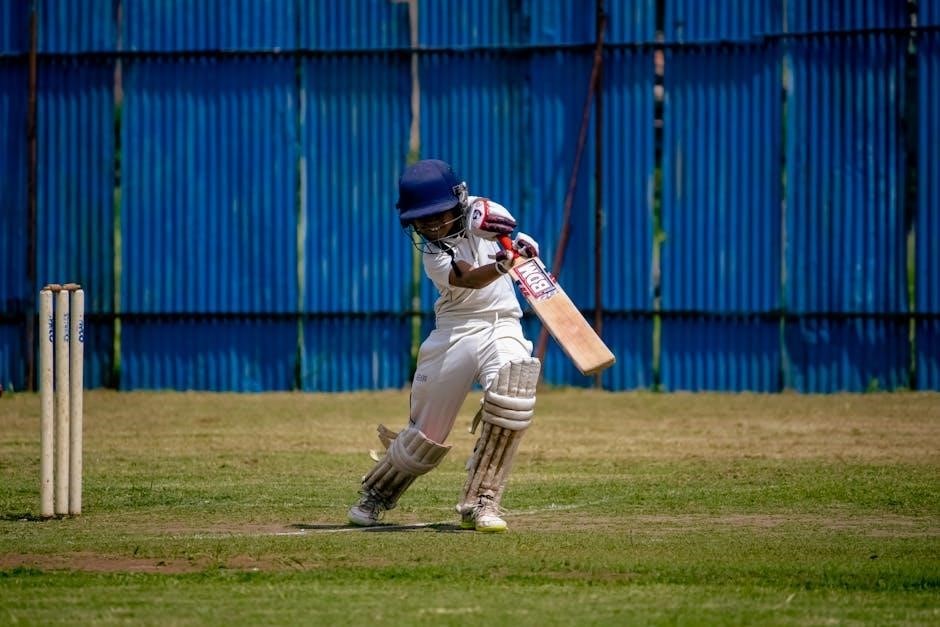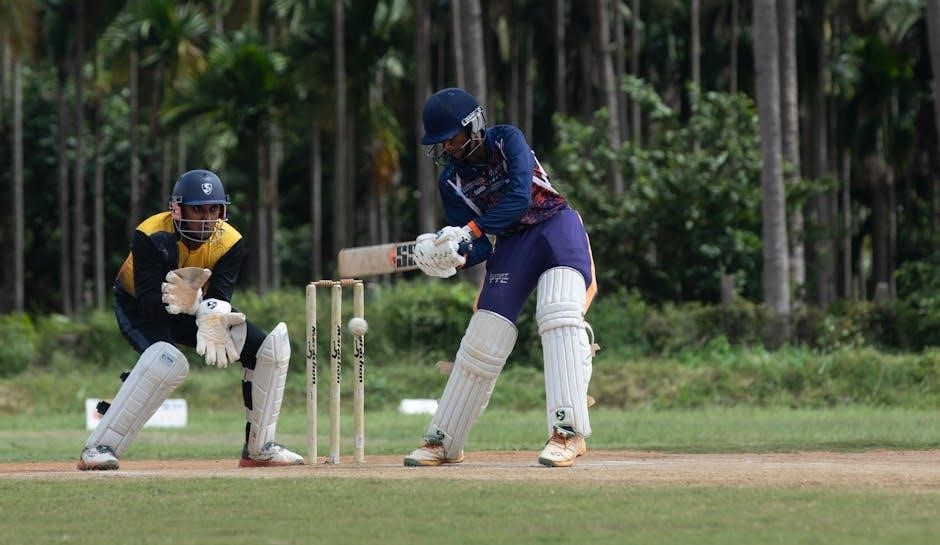Cricket bat sizing is crucial for optimal performance, ensuring proper swing balance and control. This guide covers bat sizes based on age, height, and player preferences, helping cricketers of all levels make informed choices.
1.1 Importance of Proper Bat Size
Proper bat size ensures optimal performance, balance, and control. A well-fitted bat enhances power, precision, and comfort, reducing the risk of injury. Incorrect sizing can hinder technique, limit stroke play, and affect overall gameplay confidence. Selecting the right size is vital for players to maximize their potential and enjoy the game effectively. It also supports proper skill development, especially for juniors, and adheres to regulatory standards for fair play.
1;2 Overview of Bat Size Variations
Cricket bats vary significantly in size to cater to different age groups, heights, and player preferences. Junior bats are smaller and lighter, designed for younger players, while senior bats are larger and heavier, suited for adult cricketers. Sizes range from smaller options like Harrow and Academy bats to full-size models, including short and long handle variations. These variations ensure optimal performance and comfort for players of all levels and physical stature.
Cricket Bat Size Guide Based on Age and Height
A cricket bat size guide based on age and height ensures players select the right bat for optimal performance. Proper sizing enhances comfort and efficiency for all cricketers.
2.1 Junior Bat Sizes (4-13 Years Old)
Junior cricket bat sizes are designed for players aged 4-13 years, with bats scaled down in length and weight. Sizes range from 25 1/4 inches for 4-5 years olds to 27 3/4 inches for 6-7 years olds. These bats are tailored to suit growing players, ensuring comfort and ease of handling, while promoting proper technique development from a young age.
2.2 Senior Bat Sizes (14+ Years Old)
Senior cricket bats are designed for players aged 14 and above, with sizes tailored to meet the needs of adult cricketers. Full-size bats are ideal for taller players, while small adult or academy sizes suit shorter players. Handle length and blade dimensions vary, ensuring optimal weight distribution and balance. These bats are crafted to enhance performance, providing players with maximum control and power during gameplay.

Key Components of a Cricket Bat
A cricket bat consists of a blade and handle. The blade includes the face, edges, and sweet spot, while the handle enhances control and absorbs shock.
3.1 Blade Length and Width
The blade length typically ranges from 27 to 33 inches, with widths varying between 4 to 4.25 inches. Junior bats are smaller, while senior bats are longer and wider for better performance.

3.2 Handle Length and Thickness
Cricket bat handles typically range from 10 to 12 inches in length for senior bats, with junior bats being slightly shorter. Thickness varies, balancing comfort and control. Handles are usually thicker for senior players and slimmer for juniors, ensuring ease of grip. Materials and player preference influence handle size, with some favoring thicker handles for better shock absorption and maneuverability.

Weight of Cricket Bats
Cricket bats weigh between 2lb7oz and 2lb12oz, with light bats (2lb7oz-2lb9oz) ideal for quick strokes and heavy bats (2lb12oz+) offering maximum power, while medium weights balance both.
4.1 Light, Medium, and Heavy Bats
Light bats (2lb7oz-2lb9oz) suit aggressive players needing quick reflexes. Medium bats (2lb10oz-2lb11oz) balance power and control, ideal for all-rounders. Heavy bats (2lb12oz+) deliver maximum power, favored by strong hitters. Weight distribution impacts performance, with lighter bats enhancing maneuverability and heavier ones maximizing stroke impact, catering to diverse playing styles and preferences among cricketers.
4.2 How Weight Affects Performance
Bat weight significantly impacts performance, influencing stroke play and control. Lighter bats enhance agility and back-foot strokes, ideal for precise players. Medium-weight bats balance power and maneuverability, suiting all-rounders. Heavier bats generate maximum power but may reduce handling speed. The optimal weight depends on a player’s strength, style, and role, ensuring they can execute strokes effectively without compromising timing or energy transfer.
Materials and Their Impact on Bat Size
Cricket bats are made from Kashmir or English willow, affecting size and performance. English willow is softer, offering a larger sweet spot, while Kashmir willow is denser and more durable. Handles vary in thickness and material, impacting weight distribution and control.
5.1 Willow Types (Kashmir vs. English Willow)
Cricket bats are crafted from Kashmir or English willow, each offering unique characteristics. English willow is softer, producing a larger sweet spot for better performance, while Kashmir willow is denser, offering durability. The choice impacts bat size, weight, and swing balance, with English willow preferred for senior players and Kashmir for juniors due to cost and longevity. Handle materials further influence weight distribution and control.
5.2 Junior vs. Senior Bat Construction
Junior bats are smaller and lighter, designed for young players, with shorter blades and thinner handles for easier control. Senior bats are larger, with longer blades and thicker handles, offering more power. Junior bats focus on maneuverability, while senior bats prioritize performance and durability, catering to advanced players’ needs for optimal swing and impact.

Choosing the Right Bat Size
Proper bat size ensures optimal performance, with fitting based on height, hand size, and practical trials. Measure player height, hand span, and test swing comfort for the best fit.
6.1 Measuring by Player Height
Player height is a primary factor in determining bat size. Junior bats range from size 4 (4-5 years, up to 4ft 3in) to size 6 (6-7 years, 4ft 3-4ft 6). Seniors typically use full-size bats for heights over 5ft 7in. Approximate height ranges guide bat length and handle size, ensuring comfort and control. Always refer to manufacturer charts for precise measurements, as sizes may vary slightly by brand.
6.2 Measuring by Hand Size
Hand size plays a role in determining bat fit, as it affects grip and control. Measure from the wrist crease to the tip of the middle finger. This helps ensure the handle thickness and length suit the player’s grasp. Proper hand size alignment enhances batting technique and comfort. Manufacturers often provide size charts for hand measurements, ensuring a tailored fit for optimal performance and confidence at the crease.
6.3 Practical Trial and Fitting
Practical trial and fitting are essential for ensuring the bat feels right in the player’s hands. While size guides provide a starting point, the actual feel of the bat’s balance and weight is crucial. Players should swing the bat properly to assess comfort and control. Trying different bats helps identify the best fit, enhancing performance and confidence. Proper fitting ensures optimal technique and game enjoyment.
Recent Trends in Cricket Bat Sizes
Modern cricket bats are evolving with IPL regulations and player preferences. Bats now emphasize larger sweet spots for power hitting, while size checks ensure compliance with league standards.
7.1 IPL Regulations and Bat Size Checks
The IPL has introduced strict bat size checks using a triangular gauge tool to ensure compliance with legal dimensions. This regulation, implemented in 2025, allows umpires to conduct random inspections during matches, maintaining fair play and standardization across the league. The tool measures the bat’s edges, depths, and overall dimensions, ensuring adherence to prescribed limits. This initiative aims to uphold game integrity and uniformity.
7.2 Modern Preferences for Bat Dimensions
Modern cricketers often prefer bats with larger sweet spots and balanced weights for enhanced performance. The trend leans toward bats with optimized handle lengths and blade widths, offering better control and power. Players also favor bats with specific weight ranges, such as 2.8 to 3.0 lbs, for improved maneuverability. These preferences reflect the evolution of the game, emphasizing adaptability and versatility in stroke play.
Top-Rated Cricket Bats by Size
Top-rated cricket bats vary by size and brand, with popular choices like Kookaburra, Gray-Nicolls, and SG. The Kookaburra Stealth is often praised for its value and performance, making it a favorite among players of all levels.
8.1 Best Value Bats for Junior Players
Junior players benefit from bats designed for their size and skill level. Brands like Kookaburra and Gray-Nicolls offer excellent value options, with models like the Kookaburra Kahuna Junior. These bats are lightweight, durable, and feature smaller blades for easier handling. They are typically priced affordably, making them ideal for young cricketers. The Kookaburra Stealth, now discounted, is another popular choice, providing quality performance at a budget-friendly price for developing players.
8.2 Popular Choices for Senior Players
Senior players often prefer bats that combine performance and durability. Top-tier brands like Kookaburra, Gray-Nicolls, and SS offer highly-rated models such as the Kookaburra Beast and Gray-Nicolls Powerbow. These bats feature optimized balance, larger sweet spots, and premium willow quality, catering to advanced players. They are popular among professionals and amateur enthusiasts alike, ensuring superior power and control for impactful gameplay.
Choosing the right cricket bat size ensures optimal performance and comfort. Proper sizing enhances gameplay, offering better balance and control for players of all skill levels and ages.
9.1 Final Tips for Selecting the Ideal Bat
Consider player height, weight, and personal preference when choosing a bat. Ensure proper sizing for comfort and performance. Lighter bats suit younger players, while heavier bats are for experienced cricketers. Always measure by height and hand size, and consider materials like willow type. Practical trials are essential for the best fit. Seek expert advice to avoid compromising on quality and suitability for your playing style and needs.
9.2 Importance of Proper Sizing for Performance
Proper bat sizing is crucial for optimal performance, as it ensures balance, control, and power. A well-fitted bat enhances gameplay, allowing for precise strokes and reduced fatigue. Incorrect sizing can hinder technique, limit stroke play, and cause discomfort. Ensuring the right size tailored to age, height, and skill level is essential for maximizing potential and enjoying the game effectively. Always consult size guides or experts for the best fit.

Additional Resources
Explore manufacturer guides, expert reviews, and interactive tools for detailed bat size charts. Visit Gray-Nicholls and other reputable brands for comprehensive resources and sizing support.
10.1 Size Charts and Manufacturer Guides
Reputable brands like Gray-Nicholls provide detailed size charts, categorizing bats by age, height, and player type. These guides include measurements for blade length, handle size, and overall bat dimensions. Manufacturers often offer downloadable charts to help cricketers find the perfect fit. Additionally, many websites feature interactive tools for precise sizing based on individual preferences and playing styles, ensuring optimal performance and comfort.
10.2 Expert Recommendations and Reviews
Experts recommend consulting manufacturer guides and reviews to find the ideal bat size. Platforms like The Cricketer highlight top-rated bats, such as the Kookaburra Stealth, praised for its value and performance. Reviews emphasize the importance of proper sizing for optimal play, with experts advising players to consider both personal fit and batting style when selecting a bat.